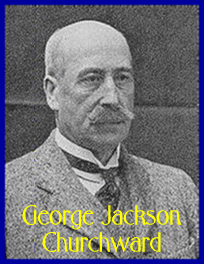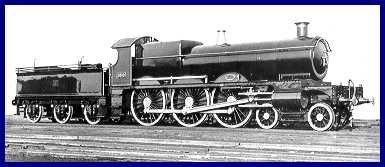George Jackson Churchward
A Swindon Locomotive Legend
The engine was directly descended from those that he himself had designed and this irony somehow add evens more fuel to the legendary quality of the story of Churchward, revered as easily one of the greatest railway designers in history. Although Churchward did not take overall control of engineering until 1902, the failing health of his predecessor, William Dean, meant that he was actually wielding power some years before this and his hand can clearly be seen in designs produced while Dean was still officially in charge. Churchward had worked his way up through the ranks after early experiences with his 'home' railway, the South Devon. When that was merged into the GWR, Churchward became one of Dean's pupils, being appointed to inspector of materials, then assistant to the carriage works manager and subsequently manager. He switched to the locomotive side in 1895 as first assistant and then locomotive works manager. In 1897 he was made chief assistant to Dean and appears to have effectively succeeded him in all but name by 1899 when he was granted a substantial increase in salary.
Churchward wasted no time in putting into practice his theories on boilers and, prompted by his studies of American locomotives, instigated a radical new trend in design. Ironically, though, it was the City of Truro, which really belonged to the older generation of engines, that brought Churchward his first national fame, becoming the first locomotive to clock up a speed of over 100mph in 1903. But Churchward had by then already unveiled his new breed of locomotives with their classic 4-6-0 wheel arrangement. No. 100 - later renamed William Dean - had few admirers when it was rolled out of Swindon Works in February 1902, primarily because it had 'outside cylinders', virtual heresy to GWR purists of the time.
In hindsight, it is difficult to find a more handsome looking engine in the history of the species (see picture, left). But if the steam engine had undergone a metamorphosis on the outside, internally there was a revolution taking place as well.
Churchward introduced a programme of standardisation of all parts of the locomotive - most notably boilers - which made them even more efficient through cost effectiveness.
There were also important developments in a wider sphere, Swindon now edging ahead of the GWR's northern works at Wolverhampton. From 1908 all of the company's locomotives were built at Swindon and the era also saw the building of a local landmark, Churchward obtaining the go-ahead for the massive 'A' Shop.
The Works doubled in size during his era.
Although Churchward was already in his mid-40s when he succeeded Dean, he surrounded himself with talented young engineers which reflected his fresh approach to design. He also instigated more formal education of staff and a number of engineers were even despatched abroad to learn from foreign railways.
Churchward also made frequent visits to the Works' drawing office and shops where he had a reputation as a good listener to suggestions from all quarters but also for being blunt and outspoken if he came across evidence of malpractice or inefficiency.
Still advances were made in design and Churchward produced Britain's first Pacific class engine (ie a wheel arrangement of 4-6-2), called The Great Bear (see picture, right).
If there was any doubt that Churchward and his Swindon factory were now at the forefront of British design, this massive machine, weighing 145 tonnes, put the matter beyond doubt.
It was around this time that Churchward's position received a new title - chief mechanical engineer - but he was also, like those who had gone before him, responsible as much for the social welfare of the town of Swindon, which depended so much on the railway, as he was engineering matters. When the separate towns of Old and New Swindon were amalgamated in a new borough in 1900, it was Churchward who was appointed as the first mayor.
Social questions, though, certainly brought problems for him, not least because of union unrest over working conditions and especially pay, with many skilled workers joining an exodus in search of better salaries with other railways, including foreign ones. It didn't help that Churchward's innovations and the increased efficiency of manufacture and maintenance caused a marked decline in the workforce, especially among boilermakers. It was also the era of Alfred Williams, the 'Hammerman Poet', who recalls in detail the harsh conditions of life inside The Factory.
But these were still "the glorious years" of Swindon Works according to its most eminent historian, Alan S Peck, who adds: "It can be said that Churchward's life work was completed by 1911, after only nine years in office. Other work was to come from him, but only building on the firm foundations laid previously." It was fortunate that Churchward had already achieved his ambitions because any advancement in the science of railways was soon to be brought to a halt by the First World War.
The commencement of hostilities on 4 August 1914 was marked by ten long blasts on the Works hooter and a large proportion of Swindon's labour force marched off to war. They left behind a factory now heavily concerned with manufacture for the war effort. Churchward was to be awarded the CBE and three of his senior managers, including Charles Collett, his eventual successor, were to receive the OBE for their services to munitions production.
But it was a very different post-War world with social unrest, depression and the beginning of a decline in railways. Churchward, by 1921, decided "it is time the old man retired", and made way for Collett. Though Churchward had been renowned for his "bluff and apparently stiff demeanour" he commanded massive respect among the Swindon workforce and was still revered in 1933, the year of his tragic death. Apart from the pioneers of railways in the earliest days, nobody is considered a greater railway engineer.
• The engine that killed Churchward was the Paddington to Fishguard express, pulled by The Berkeley Castle (No. 4085). Designed by Collett, it was a direct descendent of Churchward's own design. Though by then he had long since retired, it is believed that Churchward was examining a loose rail joint when the accident happened. It is thought that he had been unaware of the approaching train due to a combination of deafness and misty weather. His body was discovered several minutes after the express had passed. The accident happened close to his home, Newburn House, which the GWR had allowed him to retain in his retirement. • Schoolteachers reported that the young Churchward was brilliant at mathematics but still retained an appeciation of the countryside. • Churchward, who never married, lived at Newburn House, which stood at the western end of Dean Street, with his four servants - a chauffeur, a housekeeper and two maids. • Churchward is remembered for his advancements in carriage design as well as for being a great locomotive designer. He introduced the GWR's first steel-roofed coaches. • Swindon Works' famous 'A' Shop, instigated by Churchward, was designed and built by the Works' own workforce. Square in plan and covering over 5 acres, it was capable of producing up to 70 engines per year and repairing 600. It had its own power station and a revolutionary testing plant, yet it soon proved inadequate for the engines that Churchward was producing and had to be extended. • There are two reminders of Churchward in Swindon today. Churchward Avenue was built and named after him in 1936 and part of the redeveloped Works also bears his name. • Churchward is buried at Christ Church in Old Town. • The City of Truro, built in 1903, is possibly the GWR's most famous locomotive. As well as being the first to reach a speed of over 100mph, it also has the distinction of being the only real life mainline train featured in the Thomas The Tank Engine children's stories by Rev W Awdry. |
|
||||||||
|
||||||||
|
||||||||
|
||||||||
|
||||||||
|
||||||||
|
||||||||
|
||||||||
|
||||||||
|
||||||||




















